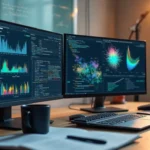
So, here’s the deal. I’ve been in the data world for a bit, and I’ve seen a lot of changes. One thing that hasn’t changed, though, is the need for good stats knowledge. If you’re a data professional, or you want to be one, you really need to get a handle on certain statistical concepts. Seriously, it’s not just about crunching numbers anymore. It’s about understanding what those numbers actually mean and how to use them to make smart choices. If you don’t, well, you might find yourself falling behind. This article is all about the statistics I think are most important for anyone working with data today.
- The Indispensable Role of Inferential Statistics
- Hypothesis Testing: The Cornerstone of Data-Driven Insights
- Regression Analysis: Unveiling Relationships and Predictions
- Experimental Design: Crafting Robust Data Collection Strategies
- Bayesian Statistics: A Modern Approach to Uncertainty
- Time Series Analysis: Forecasting Future Trends
- Multivariate Analysis: Exploring Complex Data Structures
- Conclusion
- Frequently Asked Questions
Key Takeaways
- Understanding inferential statistics helps you go beyond simple summaries and make smarter business choices.
- Hypothesis testing is super important for figuring out if your ideas are actually true, especially in A/B tests.
- Regression analysis lets you see how different things relate to each other and helps you guess what might happen next.
- Good experimental design means you collect data in a way that gives you reliable results, without a lot of mistakes.
- Bayesian statistics is a modern way to think about uncertainty, letting you use what you already know and update it with new information.
The Indispensable Role of Inferential Statistics
Moving Beyond Descriptive Summaries
Descriptive statistics are fine for summarizing data, but they only tell you about that specific dataset. Inferential statistics? That’s where the real magic happens. I’m talking about drawing conclusions about a larger population based on a sample. It’s about making educated guesses, not just stating the obvious. Think of it like this: descriptive stats are like reading a book report, while inferential stats are like reading the book and forming your own opinions. It’s a game changer for anyone serious about data.
Making Informed Business Decisions
Business decisions based on gut feelings? Those days are over. Now, it’s all about data. But raw data alone isn’t enough. I need to use inferential statistics to turn that data into actionable insights. For example, I might use hypothesis testing to see if a new marketing campaign actually increases sales, or regression analysis to predict future demand. It’s about using data to reduce risk and improve outcomes. The importance of data analysis skills can’t be overstated here. It’s the difference between guessing and knowing.
Quantifying Uncertainty and Risk
Life is uncertain, and so is data. Inferential statistics helps me quantify that uncertainty. I can calculate confidence intervals to estimate the range of possible values for a population parameter, or use probability distributions to model the likelihood of different outcomes. This is especially important in risk management. If I can understand the potential risks, I can take steps to mitigate them. It’s not about eliminating uncertainty, but about managing it effectively. This is a key component of data literacy for professionals.
Inferential statistics is not just a set of tools; it’s a way of thinking. It’s about being skeptical, asking questions, and using data to support your claims. It’s about understanding the limitations of your data and the assumptions you’re making. It’s about being honest and transparent in your analysis.
Here are some examples of how I use inferential statistics to quantify uncertainty:
- Calculating confidence intervals for sales forecasts.
- Using hypothesis testing to assess the effectiveness of a new drug.
- Building predictive models to estimate the probability of customer churn.
Hypothesis Testing: The Cornerstone of Data-Driven Insights
I think hypothesis testing is super important. It’s one of those essential data analytics skills that can really set you apart. Without it, you’re just guessing, and in today’s world, guessing isn’t good enough. We need to make decisions based on evidence, and that’s where hypothesis testing comes in. The data skills gap is real, and mastering this is a big step toward closing it.
Formulating Testable Questions
It all starts with a question. But not just any question – a testable question. This means you can actually design an experiment or study to gather data that will help you answer it. For example, instead of asking “Is my website good?” you might ask “Does changing the button color on my website increase click-through rates?” The second question is much more specific and allows you to design a test around it.
Interpreting P-Values and Confidence Intervals
P-values and confidence intervals are the bread and butter of hypothesis testing. They tell you how likely it is that your results are due to chance. A small p-value (typically less than 0.05) suggests that your results are statistically significant, meaning they’re unlikely to have occurred randomly. Confidence intervals provide a range of values within which the true population parameter is likely to fall. Understanding how to interpret these values is key to drawing meaningful conclusions from your data.
Avoiding Common Pitfalls in A/B Testing
A/B testing is a common application of hypothesis testing, but it’s easy to mess up. Here are a few things I always keep in mind:
- Make sure you have a large enough sample size. Too few participants, and your results might not be reliable.
- Run your tests for a sufficient amount of time. You need to account for variations in user behavior over time.
- Don’t stop the test early just because you see a result you like. Let the test run its course to avoid bias.
Hypothesis testing isn’t just about crunching numbers; it’s about critical thinking. It’s about asking the right questions, designing experiments carefully, and interpreting results thoughtfully. It’s a skill that every data professional needs to have in their toolkit.
Regression Analysis: Unveiling Relationships and Predictions
Regression analysis is where things get really interesting, in my opinion. It’s not just about describing data; it’s about understanding how different variables relate to each other and making predictions based on those relationships. I find it incredibly useful for uncovering hidden patterns and making informed decisions.
Understanding Linear and Logistic Models
Linear regression is probably the first type of regression most people learn. It’s all about finding the best-fitting line to describe the relationship between a dependent variable and one or more independent variables. Logistic regression, on the other hand, is used when the dependent variable is categorical, like yes/no or true/false. I’ve used both extensively, and it’s amazing how much insight you can gain from these models.
Identifying Key Predictor Variables
One of the most important aspects of regression analysis is figuring out which variables are actually driving the outcome you’re interested in. This involves looking at things like p-values and coefficients to determine the significance of each predictor. It’s not enough to just throw a bunch of variables into a model; you need to carefully consider which ones are truly important. I often use techniques like stepwise regression or regularization to help me identify the most relevant predictors.
Assessing Model Fit and Performance
Building a regression model is only half the battle. You also need to make sure it’s actually a good model! This involves assessing how well the model fits the data and how accurately it can make predictions on new data. I typically use metrics like R-squared, mean squared error, and root mean squared error to evaluate model performance. It’s also important to check for things like multicollinearity and heteroscedasticity, which can affect the validity of your results. I also like to use cross-validation techniques to get a more realistic estimate of how well the model will perform in the real world.
Regression analysis is a powerful tool, but it’s important to remember that correlation does not equal causation. Just because two variables are related doesn’t mean that one causes the other. You need to carefully consider the context and potential confounding factors before drawing any conclusions.
Here’s a simple example of how I might present regression results:
| Predictor Variable | Coefficient | P-value |
|---|---|---|
| Age | 0.5 | 0.01 |
| Income | 0.2 | 0.05 |
| Education | 0.8 | 0.001 |
This table shows the estimated coefficients and p-values for each predictor variable in a linear regression model. The p-values indicate the statistical significance of each predictor. This is a key part of statistical analysis.
Here are some common steps I follow when building a regression model:
- Define the research question and identify the dependent and independent variables.
- Collect and clean the data.
- Build the regression model and assess its fit and performance.
- Interpret the results and draw conclusions.
- Communicate the findings to stakeholders.
Experimental Design: Crafting Robust Data Collection Strategies

I’ve learned that good data is the bedrock of any sound analysis. If you start with garbage, you’ll end with garbage, no matter how fancy your statistical methods are. That’s where experimental design comes in. It’s all about setting up your data collection in a way that minimizes bias and maximizes your ability to draw meaningful conclusions. It’s not just about gathering numbers; it’s about gathering good numbers.
Principles of Randomization and Control
Randomization and control are the twin pillars of solid experimental design. Randomization helps to distribute unknown factors evenly across your groups, so you can be more confident that any differences you observe are actually due to the thing you’re testing. Control, on the other hand, involves setting up a control group that doesn’t receive the treatment or intervention you’re interested in. This gives you a baseline to compare against.
- Randomly assign participants to groups.
- Use a control group for comparison.
- Control for extraneous variables.
Designing Effective A/B Tests
A/B testing is a specific type of experiment where you compare two versions of something (like a website, an email, or an ad) to see which performs better. The key is to change only one thing at a time, so you know exactly what’s driving the difference. I’ve found that careful planning and clear metrics are essential for successful A/B tests. You need to define what “better” means in measurable terms.
Minimizing Bias in Data Gathering
Bias can creep into your data in all sorts of sneaky ways. It’s important to be aware of the potential sources of bias and take steps to mitigate them. This might involve things like using double-blind procedures (where neither the participants nor the researchers know who’s in which group), carefully wording survey questions to avoid leading responses, and being transparent about your methods. I always try to be as objective as possible when collecting and analyzing data. One way to do this is to perform exploratory data analysis to understand the data better.
It’s easy to fall into the trap of seeing what you want to see in your data. That’s why it’s so important to have a rigorous experimental design and to be vigilant about minimizing bias. Your conclusions are only as good as the data you collect.
Bayesian Statistics: A Modern Approach to Uncertainty
I think Bayesian statistics is really interesting because it gives us a different way to think about probability. It’s not just about frequencies; it’s about updating what we believe as we get more data. It feels more intuitive to me than traditional methods, especially when dealing with messy, real-world problems.
Incorporating Prior Knowledge into Analysis
One of the coolest things about Bayesian stats is that I can use what I already know. It’s not like I’m starting from scratch every time. I can put my existing knowledge, or ‘prior’, right into the analysis. For example, if I’m testing a new drug, I can use previous research to inform my initial assumptions. This makes the results more relevant and personalized to the specific situation. It’s like saying, “Okay, I think this is probably true, but let’s see what the data says.”
Updating Beliefs with New Evidence
The core of Bayesian statistics is updating my beliefs as I get new data. It’s a continuous learning process. I start with a prior belief, then I see the evidence, and then I update my belief to get a posterior belief. This posterior then becomes my new prior when more data comes in. It’s a cycle of learning and refinement. It’s like constantly adjusting my course based on new information. This approach is especially useful when data is limited or noisy.
Practical Applications in Machine Learning
I’ve found that Bayesian methods are becoming increasingly important in machine learning. They’re great for things like:
- Model selection: Choosing the best model based on the data.
- Regularization: Preventing overfitting by incorporating prior beliefs about model complexity.
- Uncertainty quantification: Providing a measure of confidence in predictions.
Bayesian approaches allow me to build more robust and reliable machine learning models, especially when dealing with limited data or complex problems. They provide a framework for incorporating expert knowledge and quantifying uncertainty, which is crucial in many real-world applications. I find this particularly useful in areas like medical diagnosis and financial forecasting.
For example, in a medical diagnosis scenario, I can use Bayesian networks to model the relationships between symptoms and diseases. By incorporating prior knowledge about disease prevalence and symptom probabilities, I can improve the accuracy of diagnoses and provide more informative predictions. This is a powerful tool for data science for beginners and experienced practitioners alike.
Time Series Analysis: Forecasting Future Trends
Time series analysis is something I’ve been getting into more lately, and it’s way more than just drawing lines on a graph. It’s about understanding the patterns in data that change over time so we can make informed guesses about what might happen next. This is super important, especially when we think about the future of data jobs, where being able to predict trends will be a major skill.
Decomposing Trends, Seasonality, and Residuals
One of the first things I learned was how to break down a time series into its different parts. You’ve got the overall trend (is it going up or down?), the seasonality (does it repeat every year, quarter, or month?), and then the residuals (the random stuff left over). It’s like taking apart a clock to see how each gear works. For example, retail sales usually have a yearly seasonal pattern, with a big spike around the holidays. Understanding these components helps me choose the right forecasting method. I find it helpful to visualize these components separately to really grasp what’s going on.
Selecting Appropriate Forecasting Models
There are tons of different forecasting models out there, and picking the right one can feel overwhelming. Some common ones include ARIMA, Exponential Smoothing, and even more complex machine learning models like LSTMs. The best model depends on the characteristics of your data. Is it stationary? Does it have a clear trend? Is there a lot of noise? I usually start with simpler models and then move to more complex ones if needed. It’s a bit of trial and error, but that’s part of the fun. I’ve found that understanding the assumptions behind each model is key to making a good choice. For example, ARIMA models assume that the data is stationary, meaning that its statistical properties don’t change over time. If your data isn’t stationary, you’ll need to transform it before using ARIMA.
Evaluating Forecast Accuracy
So, you’ve built a model and made some predictions. How do you know if they’re any good? That’s where forecast accuracy metrics come in. Things like Mean Absolute Error (MAE), Root Mean Squared Error (RMSE), and Mean Absolute Percentage Error (MAPE) help me quantify how far off my predictions are. I always split my data into training and testing sets, so I can evaluate the model on data it hasn’t seen before. It’s also important to consider the context of the forecast. A small error might be acceptable for some applications, but not for others. For example, if I’m forecasting sales for a small business, even a small error can have a big impact on their bottom line. To become a data analyst, you need to be able to interpret these metrics and communicate them effectively to stakeholders.
Time series analysis is not just about predicting the future; it’s about understanding the past and present. By carefully examining historical data, we can gain insights into the underlying processes that drive change and make more informed decisions about the future.
Here’s a simple example of how forecast accuracy might be presented:
| Model | MAE | RMSE | MAPE (%) |
|---|---|---|---|
| ARIMA | 10.5 | 12.8 | 5.2 |
| ETS | 9.8 | 11.5 | 4.8 |
Multivariate Analysis: Exploring Complex Data Structures

Multivariate analysis is where things get really interesting. It’s about looking at multiple variables at the same time to find patterns and relationships that you’d totally miss if you were only looking at one variable at a time. It’s like trying to understand a whole orchestra instead of just listening to the flute. I find it super useful when dealing with complicated datasets.
Principal Component Analysis for Dimensionality Reduction
PCA is a technique I use to simplify data. Imagine you have a dataset with 100 columns, and many of them are correlated. PCA helps you reduce the number of columns while keeping most of the important information. It creates new, uncorrelated variables called principal components. It’s like summarizing a long book into a few key chapters. For example, in customer data, you might have many features related to spending habits. PCA can combine these into a few components that explain most of the variance.
Here’s a simple example:
| Feature | Variance Explained |
|---|---|
| Principal Comp. 1 | 60% |
| Principal Comp. 2 | 25% |
| Principal Comp. 3 | 10% |
This table shows how much each principal component explains the data’s variance. The first two components capture 85% of the variance, so you could reduce the dataset to just those two.
Cluster Analysis for Grouping Similar Data Points
Cluster analysis is all about finding groups within your data. It’s like sorting a pile of mixed-up socks into pairs. The goal is to group similar data points together based on their characteristics. K-means clustering is a popular method. I use it to segment customers, identify fraud, or even group documents by topic. It’s a great way to find hidden patterns.
Here’s how I usually approach it:
- Choose the number of clusters (K).
- Randomly initialize cluster centers.
- Assign each data point to the nearest cluster center.
- Recalculate cluster centers based on the mean of the points in each cluster.
- Repeat steps 3 and 4 until the cluster assignments don’t change much.
Factor Analysis for Uncovering Latent Variables
Factor analysis is a bit like detective work. It’s used to find underlying, unobservable variables (called factors) that explain the correlations among a set of observed variables. For example, you might have a survey with many questions about job satisfaction. Factor analysis can help you identify a few underlying factors (like work-life balance, compensation, and management support) that explain why people answer the questions the way they do.
Factor analysis is useful when you suspect that your observed variables are influenced by some hidden, underlying factors. It helps you simplify complex relationships and gain a deeper understanding of the data. It’s not always straightforward, but the insights can be really valuable.
Want to make sense of lots of information at once? Multivariate analysis helps you see how different things connect. It’s like solving a big puzzle with many pieces. To learn more about how this works and see real examples, check out my website. You’ll find easy-to-understand guides and projects that show you the power of looking at data in new ways.
Conclusion
So, I’ve talked a lot about statistics today. It might seem like a lot to take in, but honestly, it’s not as scary as it sounds. I mean, I’m just a regular person, and I figured some of this out. The way I see it, if you’re working with data, knowing your stats is just part of the job. You don’t want to be the one scratching your head when everyone else gets it. Trust me, I’ve been there. It’s a bit like learning to drive; you start slow, make some mistakes, but eventually, it clicks. And once it does, you’ll wonder how you ever got by without it. So, give it a shot. What have you got to lose?
Frequently Asked Questions
What’s the big difference between descriptive and inferential statistics?
Well, descriptive statistics just tell us what happened in our data, like the average score or the highest number. But inferential statistics helps me guess what might happen in the future or for a bigger group based on a smaller sample. It’s like looking at a few cookies to guess how the whole batch tastes.
Can you explain hypothesis testing in simple terms?
Hypothesis testing is my way of checking if an idea I have is likely true or just a fluke. I set up a ‘null hypothesis’ (which is usually that nothing is happening) and then see if my data gives me enough proof to say that the null hypothesis is probably wrong. It’s how I make sure my decisions are based on solid evidence, not just a hunch.
What’s regression analysis good for?
Regression analysis helps me figure out how one thing changes when another thing changes. For example, I might use it to see if more advertising leads to more sales. It helps me make predictions and understand what factors are most important. It’s like drawing a line through my data to see the trend.
Why is experimental design so important for me?
Experimental design is all about setting up my studies the right way so I can trust the results. It means making sure I compare things fairly, like using random groups, so I can be sure that any differences I see are because of what I changed, not just luck or other hidden factors. It helps me get good, clean data.
How is Bayesian statistics different from other types of statistics I might use?
Bayesian statistics is a cool way I can update my beliefs as I get new information. Instead of just looking at the data, I can also include what I already thought was true. It’s like having a starting guess and then adjusting that guess as I learn more. It’s really useful for situations where I don’t have a ton of data to begin with.
When would I use time series analysis?
Time series analysis is my go-to for understanding data that changes over time, like stock prices or daily temperatures. I use it to spot patterns like seasons or long-term trends, and then I can use those patterns to guess what might happen next. It’s how I try to predict the future based on the past.



